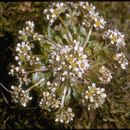en
names in breadcrumbs


Cochlearia groenlandica, known in English as Danish scurvygrass[1] or Greenland scurvy-grass, is a flowering plant of the genus Cochlearia in the family Brassicaceae.
Cochlearia groenlandica grows as a solitary plants, the size of the individual plants varying between 1–2 centimetres (0.39–0.79 in) to 15–20 centimetres (5.9–7.9 in) in diameter. The flowers are white or pale violet and 3–6 millimetres (0.12–0.24 in) in diameter. The plant flowers between June and August. Cochlearia groenlandica grows on open ground, typically beaches, tidal flats, gravelly or sandy ground and mud flat bird nesting sites. Its range is circumpolar, and present in all major Arctic regions. In North America, its range reaches from Canada and Alaska to Oregon and it has been found as far south as California.[2][3]
Cochlearia groenlandica, known in English as Danish scurvygrass or Greenland scurvy-grass, is a flowering plant of the genus Cochlearia in the family Brassicaceae.
Cochlearia groenlandica grows as a solitary plants, the size of the individual plants varying between 1–2 centimetres (0.39–0.79 in) to 15–20 centimetres (5.9–7.9 in) in diameter. The flowers are white or pale violet and 3–6 millimetres (0.12–0.24 in) in diameter. The plant flowers between June and August. Cochlearia groenlandica grows on open ground, typically beaches, tidal flats, gravelly or sandy ground and mud flat bird nesting sites. Its range is circumpolar, and present in all major Arctic regions. In North America, its range reaches from Canada and Alaska to Oregon and it has been found as far south as California.